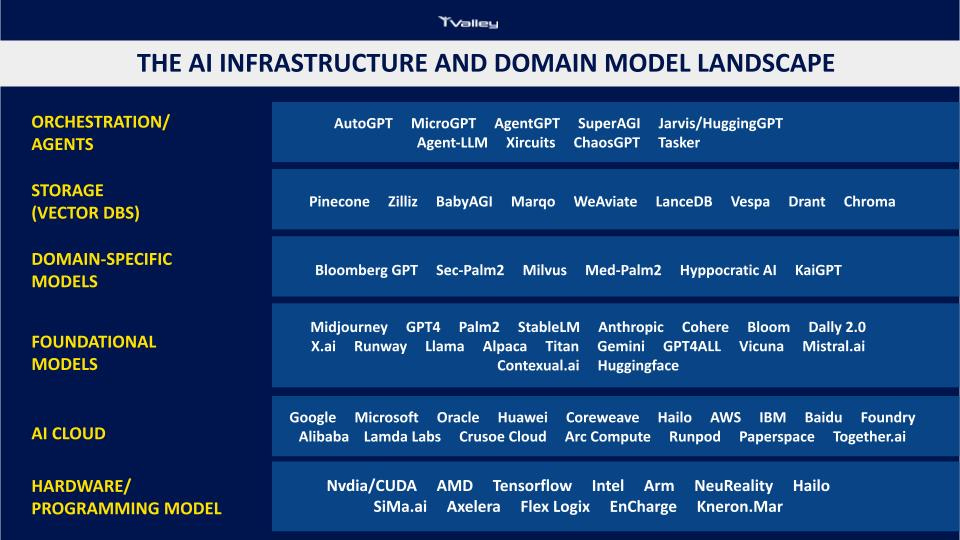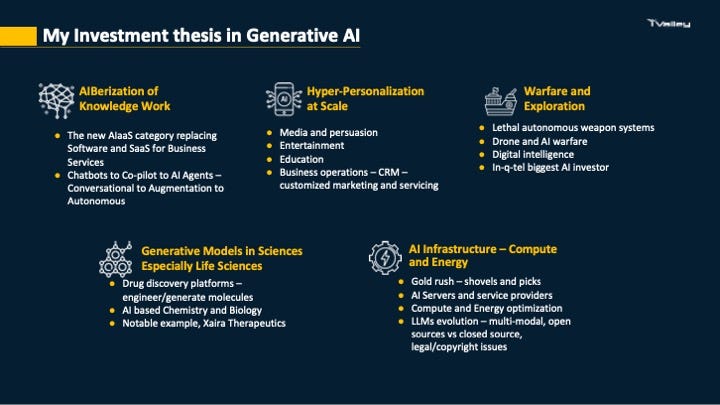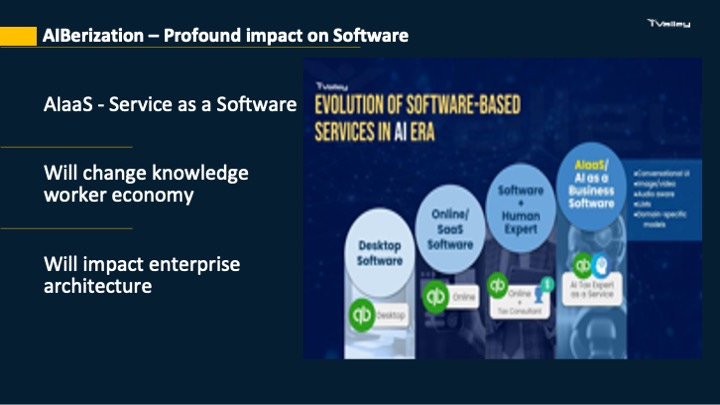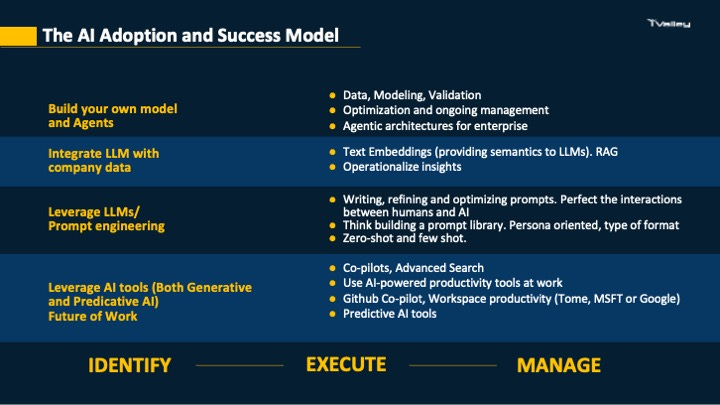Navigating the Future: The Profound Impact of Artificial Intelligence on Society and exploring its transformative power - Part 2
Economic opportunities, and Uncharted Frontiers of AI: Compute & Energy, Hyper-personalized everything at scale, and direct interface with biological intelligence
Part 1 of this series is here.
Subscribe now to have full access to the series and always be in the know.
Figure 2 - The AI landscape - an iValley perspective (for the detailed list of companies in each category see tables below)
Part 1 covered how LLMs are changing the definition of knowledge, the AIBerization phenomena, and how LLMs are being adopted in the Enterprise. In part 2, I cover economic opportunities and unchartered frontiers in AI and how hyper-personalization at scale can transform business and society.
5 “During a gold rush, sell shovels” As AI applications are built, compute and energy needs for running the payloads will continue to grow
It is said that during the San Francisco gold rush in the mid-19th century, the suppliers who sold shovels and picks to the diggers made more money than the prospectors. During the advent of the internet era, network equipment sellers like Cisco made hay. In the current AI era, it will be compute and the AI service providers.
IDC projects AI servers will grow at a 21% revenue CAGR from 2021-26 vs. 8% CAGR for the total server market, driving AI servers to grow from 18% of server industry revenue in 2022 to 27% of server industry revenue in 2026. AI training and inference are compute-intensive tasks. The two biggest components of costs for AI today are compute costs (think GPUs and NVidia stock price in the last 12 months) and the energy required for running these payloads. Just for comparison, the data center compute TAM including accelerators has maintained at 14% CAGR from 2019-2024E, with NVdia data center growth at 50% CAGR and Marvell at 30% CAGR far outpacing the CPU service growth at 2% CAGR. This will continue to be a vector of innovation with other players like AMD, Google, Intel, ARM, and a plethora of startups trying to break through. See Figure 3 bottom row below. NVIDia's GPU and the CUDA programming model have a huge advantage which speaks to its almost $1.5 Trillion market cap at the time of the writing of this article.
The opportunity is not only in compute but the energy required for compute. Sam Altman, the CEO of OpenAI remarked recently that AI will require an energy breakthrough and pushed for nuclear fusion as a solution. Several tier-2 providers and startups are trying to address the energy problem including Coreweave and Lambda Labs. See the 2nd row from the bottom in Figure 3 below. One such creative startup in this space, Crusoe, solves the energy issue by locating its data centers near remote extraction sites and harnessing industry wastes to power AI workloads. Compute and energy innovation for AI are capital-intensive and more complex than building software, yet will be the two biggest opportunities in the current AI era for both entrepreneurs and investors.
The table below lists the other areas of the AI infrastructure landscape and candidate companies including foundation models, domain domain-specific models.
Figure 3 - The AI Infrastructure landscape
6 The Transformative Applications and Pivotal Use Cases
Besides the AIBerization and knowledge economy disruption, compute, and energy discussed above, the biggest potential of AI is its ability to hyper-personalize at scale. This will have profound implications on several industry and societal phenomena that I summarize below.
6.1 Entertainment
In 2023, Hybe, the Korean music giant behind BTS, used voice AI to launch its latest artist, Midnatt, in multiple languages simultaneously. Today streaming providers like Netflix collect a lot of preference data to make recommendations of the shows one should watch.
Don’t be surprised if the next generation GenFlix, a startup being built near you, will generate entire shows based on your preferences and likes.
Imagine that - a movie with its unique cast and plot just for you generated by AI. Hyper-personalized AI-generated entertainment will take on-demand entertainment to the next level.
6.2 Persuasion - shaping public opinions, election campaigns, marketing
Remember the whole OpenAI CEO kerfuffle late in 2023? No one talks about what was happening except that OpenAI got a brand new board with Bret Taylor as its chairman. Bret Taylor was the chairman of Twitter (now X) before Elon Musk’s acquisition and when Twitter was allegedly colluding with government agencies and or political parties to censor certain points of view in an election year. These revelations were made by the Twitter files.
It appears larger forces are interested in OpenAI as the persuasion power of LLMs and distribution apps like chatGPT (or for that matter Meta AI and others) have reached a significant scale that can influence public opinion on important topics.
It took 5 days for ChatGPT to reach 1 million users and 2 months to reach 100m users.. See the chart from Statista below. It is estimated that ChatGPT has about 180 million users as of the writing of this article.
Figure 4 - Time taken to reach 1m and 100 m users. Source - CNBC, Statista and Credit Suisse
When applications reach this kind of scale and influence, they can be used for mass persuasion like shaping public opinions on topics and even elections.
They become sought-after technologies by-election campaigns and other entities as a tool for amplifying or attenuating messages - as evident from Twitter files.
Print media, Cable News, social media, and Wikipedia all have been in this before - important tools for shaping public opinion and persuasion. Some claim the Arab Spring which created a political uprising in North Africa was catalyzed by Social Media. What is different now with GenAI is that it is not only distribution but the factory of information that is changing. Just like GenFlix, the fictitious startup I reference above, GenMedia (largely LLMs-based) and distribution apps like chatGPT, Perplexity, Grok, and WhatsApp AI will become what print media, cable news, social media, and Wikipedia are today.
The media factory and distribution both will be disintermediated by GenAI leading us to a new GenMedia framework based on AI.
When leaders esp. those working in AI sign a statement saying mitigating the risks of AI should be a global priority, they are usually talking about its ability to influence public opinion and persuasion at scale; the ability of AI to create hyper-personalized multi-modal content and distribute at scale including through impersonations. It’s not the AI itself but the humans who control its training and tuning become all important and powerful.
6.3 Education - personal tutor - the printing press moment for education
Mr Sal Khan of Khan Academy in his recent TedTalk declared “We’re at the cusp of using A.I. for probably the biggest positive transformation that education has ever seen, And the way we’re going to do that is by giving every student on the planet an artificially intelligent but amazing personal tutor.” Khanamigo is a personalized AI tutor with the ultimate goal of personalizing the educational experience for each student depending on their learning style, strengths, and weaknesses. This could transform educational outcomes. The NYTimes agrees saying “Mr. Khan’s vision of tutoring bots tapped into a decades-old Silicon Valley dream: automated teaching platforms that instantly customize lessons for each student.”
“Proponents argue that developing such systems would help close achievement gaps in schools by delivering relevant, individualized instruction to children faster and more efficiently than human teachers ever could.”
AI if implemented correctly has the potential to level the playing field in education in essence providing Community Collegse and HBCUs the resources and scale of an Ivy, providing almost the capability of 1 on 1 individualized instruction for an under-performing district in k-12 education
Other providers like Gradescope and Socrates are in this solution space. See Figure 5 below.
6.4 Productivity and AI Companions
There has been an explosion of AI productivity tools from note-takers to content-writing tools to image/video generators. See the bottom row list in Figure 5 below. Then there are AI companions like Replika which is a digital companion that can listen and talk to you. The list goes on. The risk for these standalone companies is plugins released by the big tech companies. ChatGPT has plugins in this domain with integration to Expedia, Kayak for travel, Instacart, Klarna for shopping, and such. ChatGPT has also built a Browser plugin which allows real-time access to the internet to augment GPTx (which does not have access to the internet). Rabbit.tech’s R1 pocket companion is a device like a walkie talkie which is a replacement for the app-based interface of iPhone/Android where you can just talk to it to get things done rather than navigate through apps.
6.5 Defense and Warfare
Warfare today is already being conducted by unmanned drones powered by AI. The drones have sensing capabilities (eyes and ears) and models for inference and decision on the edge (in the drone) or on the cloud. According to the Congressional Research Service “Lethal autonomous weapon systems (LAWS) are a special class of weapon systems that use sensor suites and computer algorithms to independently identify a target and employ an onboard weapon system to engage and destroy the target without manual human control of the system. Although these systems are not yet in widespread development, it is believed they would enable military operations in communications-degraded or -denied environments in which traditional systems may not be able to operate.” Companies like Anduril are already building technology and sensing systems for such weapons systems. The military superiority in the future is not just big ships and fighter planes but advances in software and AI. Just yesterday, in public information the United States Air Force awarded contracts to five companies to design and build Collaborative Combat Aircraft that can fly autonomously alongside manned platforms. The companies are Boeing, Lockheed Martin, Northrop Grumman, Anduril, General Atomics. In its fiscal 2024 budget request, the Air Force outlined plans to spend $5.8 billion on CCAs over the next five years, and $392 million in fiscal ’24 alone. Source airandspaceforces.com
Figure 5 - The AI platforms, co-pilots, apps and services
7 Where do we go from here
AI just like other major technology advancements will be a huge enabler. Just like the internet, AI will create new business models and businesses. LLMs and domain-specific models will become the foundation of knowledge almost like a curriculum for humanity. Future multi-modal versions of these capabilities, connected with sensing abilities will be able to discover new scientific principles and advance our understanding of the world around us.
The best way for practitioners to get involved is to start using AI, join one of the many AI communities like HuggingFace, or get trained on platforms like Cohere, LangChain, MosaicML, Azure Machine Learning, or Amazon SageMaker. What does it mean to be ready for the AI era? For individuals, it is upskilling on foundations of neural networks or becoming proficient in using tools like co-pilots and workspace productivity tools and applying them for business problems. Just like we had categories like search, social media, ecommerce and platform companies for the internet, what will be the categories for AI. We don’t know yet.
I believe the big categories in AI will be AIBerization of knowledge work, hyper-personalization at scale across diffrent domains, and defense besides the processors and service providers.
The debate between open-source and closed-source foundational models continues and if history is any judge with Linux, and Apache software, the open source eventually wins due to the massive pool of developers that creates an unmatchable scale. Closed-source foundational models will have to find their moat to be viable in the long run.
The AI alarmist and some of the academics will continue the AGI debate. It largely doesn't matter whether Digital Intelligence (DI more appropriate name than AI) develops self-awareness, consciousness, and such. It will appear to and there will be likely a lot of “I am afraid I can’t do that, Dave” moments. LLMs will advance from the language domain to the physical and eventually to the quantum domain. Digital intelligence will seamlessly interface with human intelligence in much more sophisticated ways than voice and typing; it will be bi-directionally integrated with biological intelligence with technologies like what Neurallink is developing. DI will be integrated with the human brain.
Advanced Digital Intelligence (DI) integrated and working seamlessly with biological intelligence will be an evolutionary leap that will have a far-reaching impact on humanity than we can imagine today.
Paddy Ramanathan Follow me on the new Twitter (X) @PaddyRamanathan
Founder of iValley (www.ivalley.co) and
Host of the FINTECHTALK™ Show (on Substack, Apple Podcast, Youtube, and Spotify)
Dr. Riad Hartani contributed to this article.
This article was updated with a mention about GenMedia on Section 6.2
Check out some of the new episodes of FINTECHTALK podcasts on AI at Apple, Spotify or YouTube links below
Epilogue - Investment Thesis and future with AI
My 5 pronged thesis on AI investment - here is it in voice at the TGV event
How AI will have profound impact on how Software and SaaS will change, it will back to basics. Taking the digital shoe box to the AI tax preparer, mumbling some verbal instructions and voila your taxes are done
My favorite where entertainment and media are gen AI. Profound ethical and societal implications not about AI going rogue but those controlling AI will have massive influence power - sort of like what Big Tech and social media has today on distribution of information but this will change the factory of information not just distribution.










